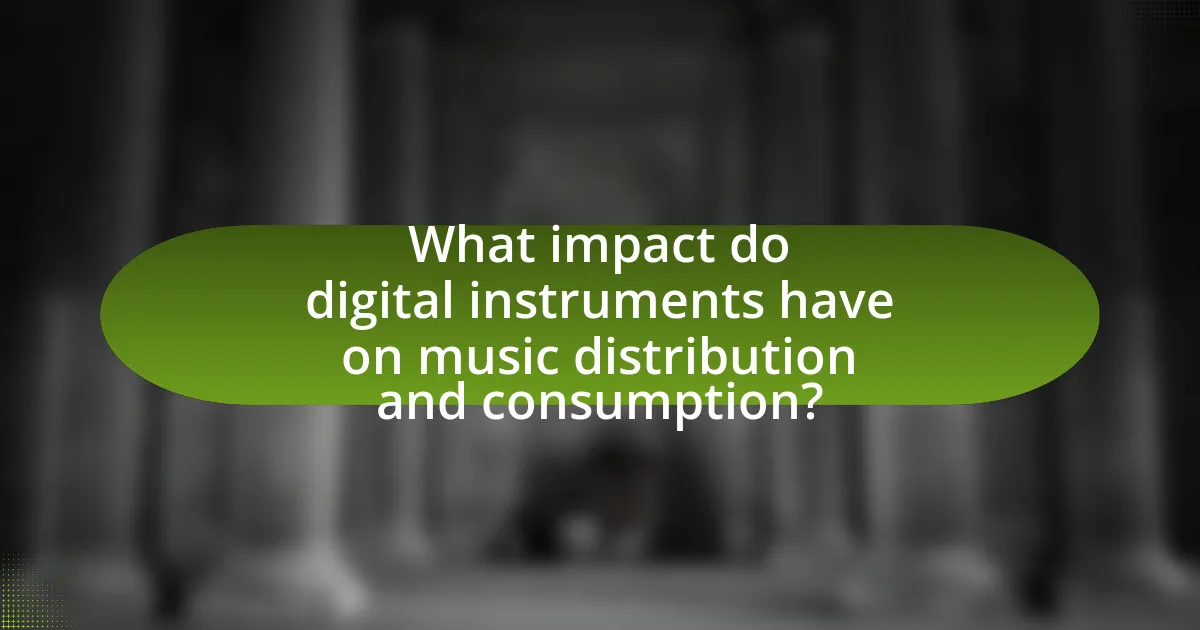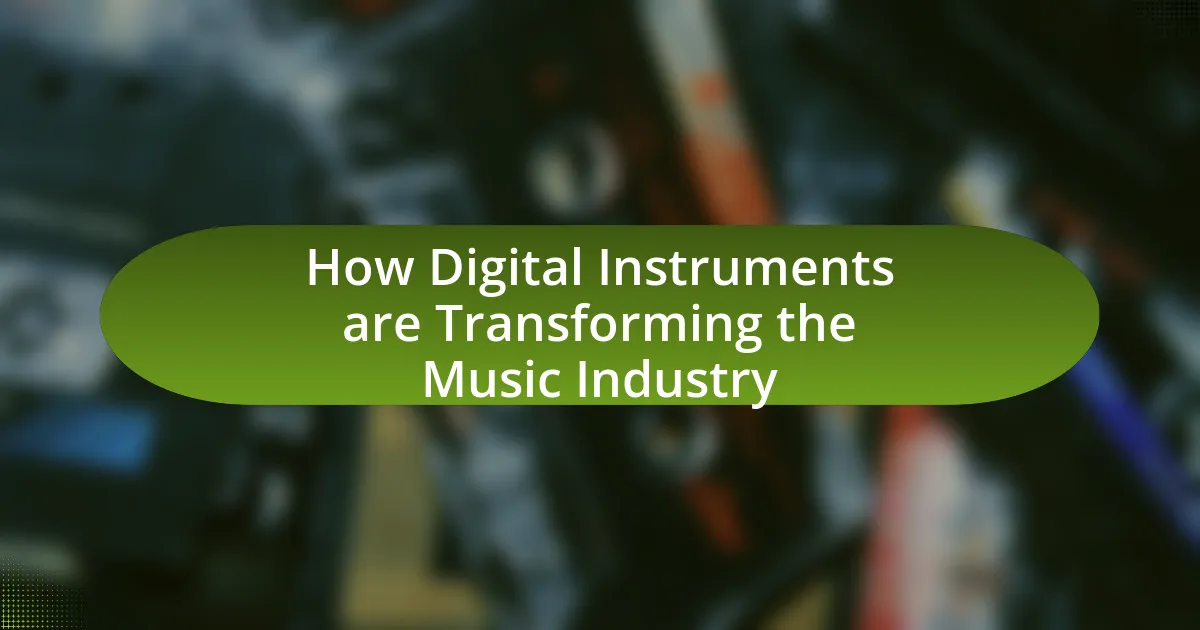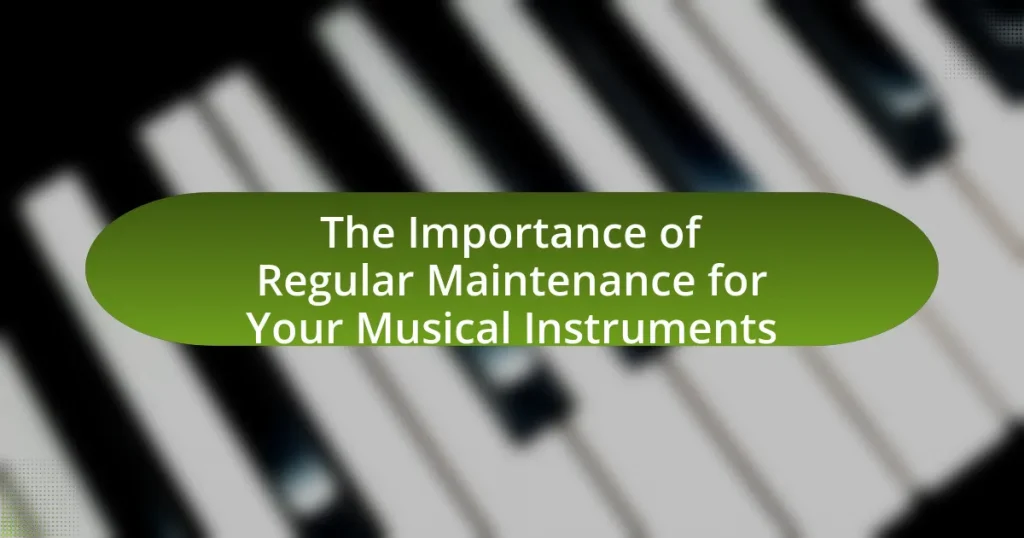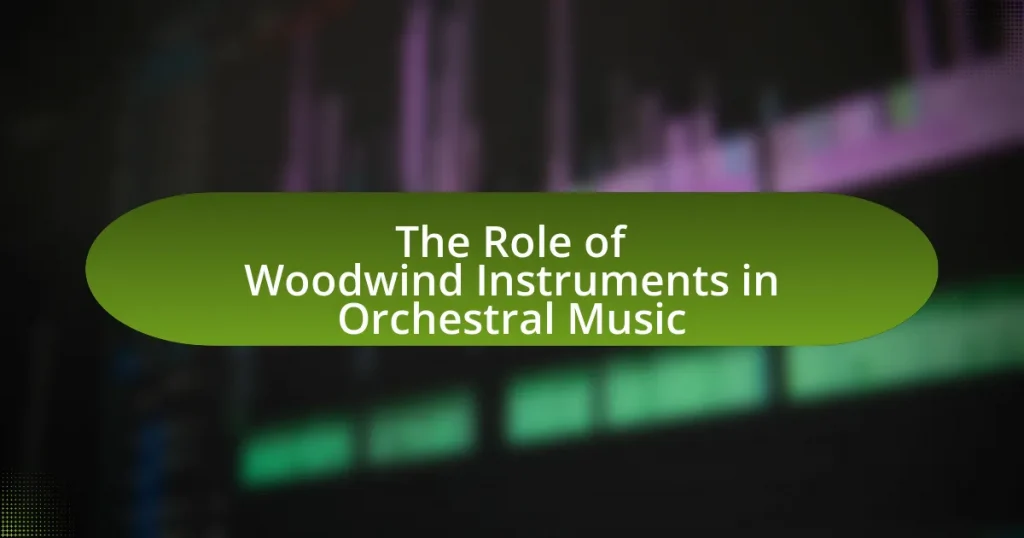Digital instruments are significantly transforming the music industry by enhancing accessibility, creativity, and production efficiency. Key types of digital instruments, including digital audio workstations (DAWs), synthesizers, and MIDI controllers, are reshaping music production techniques and enabling a broader range of artists to enter the market. The article explores how these tools facilitate collaboration, streamline music distribution, and foster experimentation, while also addressing the challenges musicians face when integrating digital instruments into their workflows. Additionally, it highlights the resources available for musicians to learn about and effectively utilize these digital tools in their creative processes.

How are Digital Instruments Changing the Landscape of the Music Industry?
Digital instruments are revolutionizing the music industry by enhancing accessibility, creativity, and production efficiency. These tools allow musicians to create, edit, and distribute music with unprecedented ease, enabling a broader range of artists to enter the market. For instance, software like Ableton Live and GarageBand provides intuitive interfaces for music creation, while platforms like SoundCloud and Bandcamp facilitate direct distribution to audiences. According to a 2021 report by the International Federation of the Phonographic Industry, digital music revenues accounted for 62% of the global recorded music market, highlighting the significant impact of digital instruments on industry dynamics.
What are the key types of digital instruments influencing music today?
The key types of digital instruments influencing music today include digital audio workstations (DAWs), synthesizers, MIDI controllers, and software plugins. Digital audio workstations, such as Ableton Live and Logic Pro, serve as comprehensive platforms for recording, editing, and producing music, allowing artists to manipulate sound with precision. Synthesizers, both hardware and software-based, generate a wide range of sounds and textures, significantly shaping modern music genres. MIDI controllers enable musicians to interact with software instruments and DAWs, providing tactile control over music production. Software plugins enhance sound design and mixing capabilities, offering effects and virtual instruments that expand creative possibilities. These digital instruments collectively transform the music industry by democratizing music production and enabling innovative sound exploration.
How do synthesizers contribute to modern music production?
Synthesizers significantly contribute to modern music production by enabling the creation of diverse sounds and textures that are essential in contemporary genres. They allow producers to manipulate waveforms, create unique timbres, and design complex soundscapes, which are crucial for genres like electronic, pop, and hip-hop. The versatility of synthesizers is evidenced by their use in iconic tracks, such as the use of the Moog synthesizer in Kraftwerk’s pioneering electronic music, which laid the groundwork for future productions. Additionally, synthesizers facilitate real-time sound manipulation and automation, enhancing the creative process and allowing for innovative compositions. Their integration into digital audio workstations (DAWs) further streamlines music production, making advanced sound design accessible to a broader range of artists.
What role do digital audio workstations (DAWs) play in music creation?
Digital audio workstations (DAWs) serve as essential tools in music creation by providing a platform for recording, editing, mixing, and producing audio. DAWs enable musicians and producers to manipulate sound through various features such as multi-track recording, MIDI sequencing, and audio effects. The widespread adoption of DAWs has transformed the music industry, allowing for greater accessibility and creativity, as evidenced by the fact that over 70% of music producers now rely on DAWs for their projects, according to a 2021 survey by the International Music Producers Association.
Why is the adoption of digital instruments increasing among musicians?
The adoption of digital instruments is increasing among musicians primarily due to their versatility and accessibility. Digital instruments offer a wide range of sounds and capabilities that traditional instruments cannot match, allowing musicians to experiment and create diverse music styles. Additionally, advancements in technology have made digital instruments more affordable and user-friendly, enabling a broader range of musicians, including beginners, to incorporate them into their practice and performances. According to a 2021 report by the International Music Products Association, the sales of digital instruments have seen a consistent annual growth rate of 10%, reflecting their rising popularity in the music industry.
What advantages do digital instruments offer over traditional instruments?
Digital instruments offer greater versatility and convenience compared to traditional instruments. They allow for a wide range of sounds and effects that can be easily manipulated, enabling musicians to explore diverse genres and styles without the need for multiple physical instruments. Additionally, digital instruments often come with built-in recording and editing capabilities, streamlining the music production process. For instance, software synthesizers can emulate various acoustic instruments and create entirely new sounds, which is not possible with traditional instruments. Furthermore, digital instruments typically require less physical space and maintenance, making them more accessible for musicians in various settings.
How do digital instruments enhance creativity and experimentation in music?
Digital instruments enhance creativity and experimentation in music by providing musicians with a vast array of sounds, tools, and functionalities that were previously unavailable or difficult to access. These instruments, such as synthesizers, digital audio workstations (DAWs), and software plugins, allow artists to manipulate sound in innovative ways, enabling them to explore new musical styles and techniques. For instance, DAWs like Ableton Live and Logic Pro offer features such as loop-based composition, real-time editing, and extensive sound libraries, which facilitate experimentation with different musical ideas and arrangements. Additionally, the accessibility of digital instruments has democratized music production, allowing a broader range of individuals to create and share their work, thus fostering a more diverse musical landscape.

What impact do digital instruments have on music distribution and consumption?
Digital instruments significantly enhance music distribution and consumption by enabling instant access and global reach. The rise of digital platforms like Spotify and Apple Music allows artists to distribute their music worldwide without traditional barriers, such as record labels. According to the International Federation of the Phonographic Industry (IFPI), global music streaming revenues reached $23.1 billion in 2020, illustrating the shift towards digital consumption. Additionally, digital instruments facilitate user-generated content, allowing consumers to create and share music easily, further transforming how music is consumed and distributed.
How are digital instruments reshaping the way music is produced and shared?
Digital instruments are reshaping music production and sharing by enabling greater accessibility, creativity, and collaboration. With software like Ableton Live and GarageBand, musicians can produce high-quality tracks from home studios, reducing the need for expensive recording facilities. Additionally, platforms such as SoundCloud and Bandcamp allow artists to share their music globally, reaching wider audiences without traditional gatekeepers. The rise of digital distribution has led to a significant increase in independent music releases; for instance, in 2020, independent artists accounted for over 40% of global music consumption, highlighting the transformative impact of digital tools on the industry.
What changes have occurred in music production techniques due to digital instruments?
Digital instruments have significantly transformed music production techniques by enabling greater accessibility, flexibility, and efficiency. The introduction of digital audio workstations (DAWs) allows producers to record, edit, and mix music with unprecedented precision and ease, facilitating complex arrangements that were previously labor-intensive. Additionally, the use of virtual instruments and plugins has expanded the sonic palette available to musicians, allowing for a wide range of sounds without the need for physical instruments. This shift has democratized music production, enabling independent artists to create high-quality recordings from home studios, as evidenced by the rise of platforms like Bandcamp and SoundCloud, which showcase music produced using digital tools.
How do digital instruments facilitate collaboration among artists globally?
Digital instruments facilitate collaboration among artists globally by providing accessible platforms for real-time communication and creative sharing. These tools, such as digital audio workstations (DAWs) and cloud-based collaboration software, enable artists from different geographical locations to work together seamlessly. For instance, platforms like Soundtrap and Splice allow musicians to upload, edit, and share their work instantly, fostering a collaborative environment regardless of distance. Additionally, the rise of social media and streaming services has further connected artists, allowing them to share ideas and collaborate on projects, thus enhancing the global music landscape.
What challenges do musicians face when integrating digital instruments?
Musicians face several challenges when integrating digital instruments, including technical complexity, learning curves, and compatibility issues. The technical complexity arises from the need to understand software and hardware configurations, which can be daunting for those accustomed to traditional instruments. Learning curves are significant, as musicians must invest time to master digital tools and software, which can detract from their creative process. Compatibility issues often occur when different digital instruments and software do not seamlessly work together, leading to frustration and potential disruptions during performances or recordings. These challenges can hinder the overall adoption of digital instruments in a musician’s workflow, impacting their ability to innovate and create effectively.
How can musicians overcome the learning curve associated with digital instruments?
Musicians can overcome the learning curve associated with digital instruments by engaging in structured practice, utilizing online tutorials, and participating in community forums. Structured practice allows musicians to focus on specific features and functionalities of digital instruments, enhancing their proficiency over time. Online tutorials provide step-by-step guidance, making complex concepts more accessible; for instance, platforms like YouTube host numerous instructional videos that cater to various skill levels. Additionally, community forums, such as those on Reddit or specialized music production websites, offer peer support and shared experiences, which can help musicians troubleshoot issues and gain insights from others who have faced similar challenges. These methods collectively facilitate a smoother transition to digital instruments, as evidenced by the increasing number of musicians who report improved skills and confidence through these resources.
What are common technical issues musicians encounter with digital instruments?
Musicians commonly encounter latency, software compatibility issues, and hardware malfunctions with digital instruments. Latency refers to the delay between input and output, which can disrupt performance; studies show that even a few milliseconds can affect timing. Software compatibility issues arise when digital instruments do not integrate seamlessly with digital audio workstations (DAWs) or other software, leading to crashes or functionality loss. Hardware malfunctions, such as faulty connections or power supply problems, can also hinder performance, with reports indicating that up to 30% of musicians experience such issues during live performances.

How can musicians effectively utilize digital instruments in their work?
Musicians can effectively utilize digital instruments by integrating them into their creative processes for composition, performance, and production. Digital instruments, such as synthesizers, MIDI controllers, and software plugins, allow musicians to explore a vast range of sounds and effects that enhance their music. For instance, the use of MIDI controllers enables real-time manipulation of sound parameters, facilitating dynamic performances and compositions. Additionally, software like Ableton Live and Logic Pro provides tools for recording, editing, and mixing, which streamline the production process. The versatility of digital instruments is evidenced by their widespread adoption in various genres, with a report from the International Federation of the Phonographic Industry indicating that over 70% of music producers now use digital audio workstations (DAWs) in their workflow. This integration not only expands creative possibilities but also increases efficiency in music production.
What best practices should musicians follow when using digital instruments?
Musicians should prioritize sound quality, proper software management, and regular updates when using digital instruments. Ensuring high sound quality involves using high-resolution audio files and quality audio interfaces, which can significantly enhance the listening experience. Proper software management includes organizing digital audio workstations (DAWs) and plugins efficiently, allowing for smoother workflow and creativity. Regular updates of software and firmware are crucial as they often include bug fixes and new features that improve functionality and security. According to a study by the Berklee College of Music, musicians who maintain their digital tools effectively report higher productivity and creativity levels.
How can musicians choose the right digital instruments for their style?
Musicians can choose the right digital instruments for their style by assessing their musical genre, desired sound, and technical proficiency. Each genre, such as electronic, rock, or classical, often has specific instruments that complement its characteristics; for example, synthesizers are prevalent in electronic music, while guitars are essential in rock. Additionally, musicians should consider the sound palette they wish to create, as different digital instruments offer unique timbres and effects that can enhance their compositions. Technical proficiency also plays a crucial role; beginners may benefit from user-friendly software and instruments, while advanced musicians might prefer more complex tools that allow for deeper customization. This approach ensures that musicians select instruments that not only align with their artistic vision but also fit their skill level, ultimately enhancing their creative output.
What tips can enhance the workflow when using digital instruments in music production?
To enhance workflow when using digital instruments in music production, musicians should implement a structured template system for their projects. This approach allows for consistent organization of tracks, effects, and instruments, which streamlines the creative process. Additionally, utilizing keyboard shortcuts specific to the digital audio workstation (DAW) can significantly reduce time spent navigating menus, thereby increasing efficiency. Research indicates that musicians who adopt templates and shortcuts can complete projects up to 30% faster, as they minimize repetitive tasks and enhance focus on creativity.
What resources are available for musicians to learn about digital instruments?
Musicians can access a variety of resources to learn about digital instruments, including online courses, tutorials, and forums. Platforms like Coursera and Udemy offer structured courses on digital music production and instrument usage, often created by industry professionals. YouTube hosts countless tutorials that cover specific digital instruments and software, providing visual and practical guidance. Additionally, forums such as Gearslutz and Reddit’s r/WeAreTheMusicMakers allow musicians to engage with peers, share experiences, and seek advice on digital instruments. These resources collectively enhance musicians’ understanding and skills in utilizing digital instruments effectively.
Where can musicians find tutorials and courses on digital instrument usage?
Musicians can find tutorials and courses on digital instrument usage on platforms such as YouTube, Coursera, and Skillshare. YouTube offers a vast array of free video tutorials covering various digital instruments, while Coursera and Skillshare provide structured courses often created by industry professionals. These platforms collectively host thousands of resources, enabling musicians to learn at their own pace and access expert knowledge on digital instrument techniques and applications.
What online communities support musicians using digital instruments?
Online communities that support musicians using digital instruments include platforms like SoundCloud, BandLab, and Reddit’s r/WeAreTheMusicMakers. SoundCloud allows musicians to share their digital compositions and receive feedback from a global audience, fostering collaboration and exposure. BandLab offers a social music creation platform where users can collaborate in real-time, providing tools for recording and mixing music digitally. Reddit’s r/WeAreTheMusicMakers serves as a forum for musicians to discuss techniques, share experiences, and seek advice on using digital instruments, creating a supportive environment for learning and growth. These communities collectively enhance the experience of musicians by providing resources, collaboration opportunities, and a space for sharing their work.



